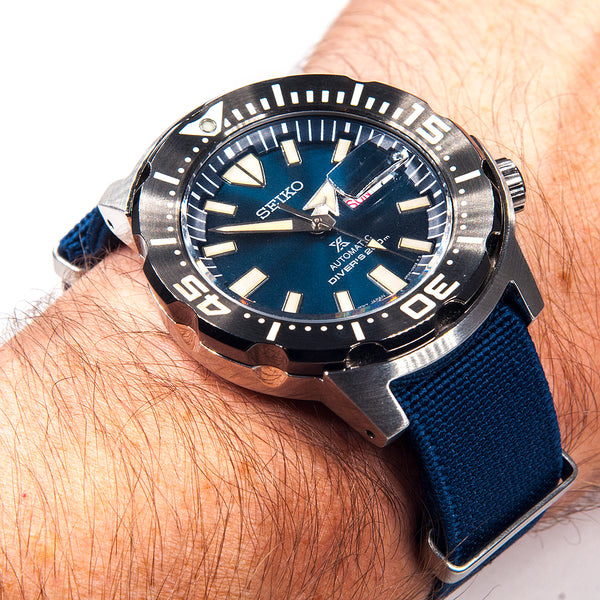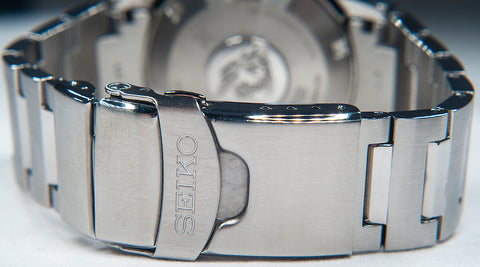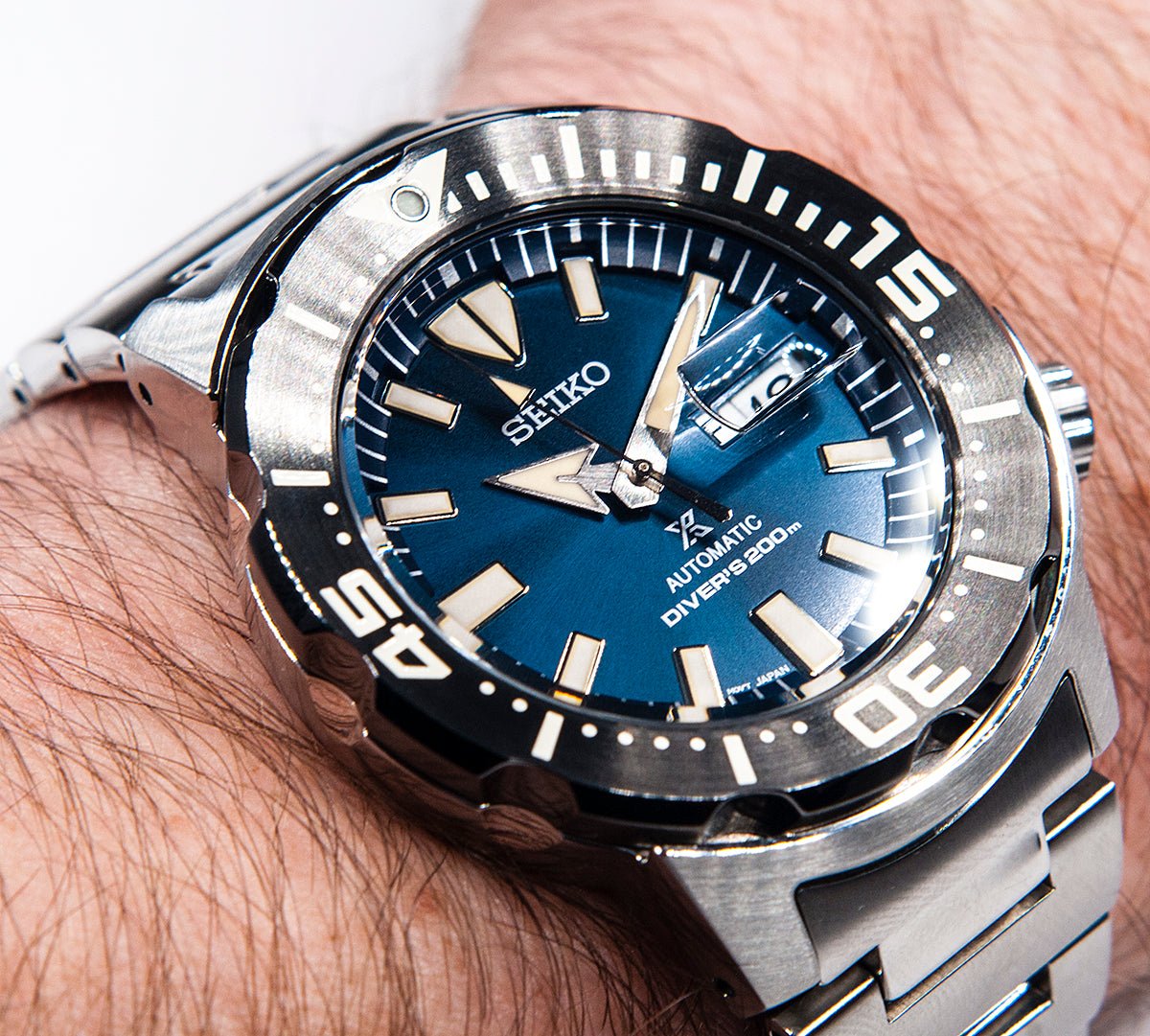
When I first started down this never-ending rabbit hole of watch collecting, one of the first watches that I purchased was the Seiko SKX781, or as you probably know it, the “Orange Monster.”

What drew me to the Orange Monster over, say, an SKX007/9 was its rugged styling, with a chunky, scalloped bezel made of brushed steel and a bright orange dial. The color was so bright that it looked like you had a piece of a fresh orange strapped to your wrist. The fact that I could get an automatic watch for under $200 (the going rate at the time) sealed the deal.
The “OM” was such a hit with me that it wasn’t too long before an SKX779, or “Black Monster,” ended up in my collection (for obvious reasons, I try not to use the abbreviation “BM” for the black colorway). What it lacked in bright color, it made up for with an almost militaristic style. Having one of each in your collection was not a crazy idea.

Fast forward to 2019, and I had long since bought and sold a handful of first-gen Monsters. I found myself missing the fun styling and decided that I needed some fun back in my watch collection.
Unfortunately, what I quickly found was that, since it has been discontinued for some time, it’s no longer easy to buy a clean SKX781. Many of them have been abused at this point, and sellers of clean ones often want over $400 for them.
I quickly expanded my search to the second-generation Orange Monster (SRP309). This model resembles the “1G” closely, but features tooth-shaped teeth and a hacking/hand-winding 4R movement. Unfortunately, these are less common, and at least as expensive as the first gens, plus I didn’t like the markers as much.
Continuing up the chain, I remembered hearing that a third-generation Monster existed, and found that a few orange sunburst dial ones were available (SBDC023). Unfortunately, these models also fell outside my budget because they feature the higher-end 6R movement, but chances are you won't even find one.
Luckily, around this time, the fourth-generation Monsters were hitting the typical markets. Unfortunately, they do not currently offer an orange version, but I ended up buying a brand-new blue dial version (SRPD25, or SBDY033 in other markets). MSRP is $525, but I found one for roughly $300 on eBay. I pulled the trigger, since I could get a BNIB fourth gen for less than a well-used first gen.


Image courtesy of seikousa.com
I missed the pop of that orange dial, but I’m always a sucker for a deep blue sunburst. Stick with me to hear my impressions of the watch, as well as a comparison to the OG OM, and some worthy alternatives.


First Impressions
Immediately, when you put on this watch, you can tell that Seiko has taken it up a notch from the original. The watch feels and looks more expensive on the wrist. The trade-off is that it has lost some of the fun and rugged character of the original.

The 42mm width and 13mm thickness are identical on both, but the new one looks bigger on the wrist. The main reason is the bezel.

Bezel
The first thing that you’ll notice about the new Monster is that the bezel has undergone some changes. Most apparent is that it is now black ion-plated.

The finishing remains similar to the first generation, with circular brushing on the top surface and polished sides. It also retains the inward slope of the bezel and scalloped cuts on the sides. The scallops are smaller on the new monster, which, combined with a smaller chamfer around the edge and the removal of the vertical cuts, makes the watch wear bigger. The bezel now stretches proudly out to the edges of the watch.

Black paint has been swapped for white, and a different font has been chosen to modernize the new watch. Both use similar minute markings, including the lume pip. The new bezel also has shallower recesses for the paint. I wonder if this makes it more likely to be chipped off.
The bezels on both watches are pretty easy to grip and turn. I could not compare them back to back, but the quality of the clicks on the new watch is smooth and secure, but doesn’t have the tighter tolerance feeling of more expensive watches.
Crystal
Both watches utilize a Hardlex (mineral) crystal. The first gen has a fun domed crystal that adds a playful distortion to the dial when viewed at an angle, without adding the cloudy look that sometimes occurs. I’m a sucker for domed crystals, and I’ve swapped them into mupltiple Seiko watches that I’ve modded.

The new watch replaces the dome with a flat mineral crystal, but then adds a long magnifier to cover the entire day and date window. This is another choice that gives the watch a more high-end look, and even though it loses the dome, it looks great with the rest of the watch. I don’t plan to change this one out.

Dial
Besides the noticeable color change, the new Monster received some additional updates on the dial.

It retains the signature notched chapter ring and has returned to the beloved rectangular applied hour markers of the original. The hour markers, however, now have a polished metal perimeter, rather than the white (I assume plastic) surrounds of the old watch.

The new dial transitions from a matte finish to a sunburst effect (even on the black SRPD27 version and the new all-black case SRPD29), and features the “X” logo to denote that the watch has been upgraded to Seiko’s Prospex line. The numbers denoting minutes are also removed from the dial, which i think cleans it up nicely.


The hands retain similar shapes, but with some streamlining, which further modernizes the watch. They also receive a brushed metal finish rather than the black or white outlines (depending on dial color) of the old watch.

As you would expect, Seiko’s fantastic Lumibrite is still used on the new watch. The surprise is that Seiko has changed it to blue! It looks great in low-light conditions, where you can still make out the blue color of the dial.

Case
The theme of streamlining and modernization continues with the case.

Both watches have a 200m water resistance. The new Monster retains the semi-shrouded case design, but swaps out the cutout crown relief for a small half-circle recess. This again detracts from the rugged look, but makes the new watch appear more elegant and also makes the crown easier to grip. The crown itself retains a similar notched design.




The new watch also has sharper edges to the case and nicer finishing all around. Thankfully, it keeps the drilled lugs! The lug shape is also similar on the old and new watches.

The case back also features an upscale design on the new watch. It retains the Seiko tsunami logo, but receives much nicer finishing, as well as a flatter surface that helps it to hug the wrist.


Overall, the watch is very comfortable for its size. The sloped lugs allow it to fit snugly against the wrist.


Bracelet
If you haven’t noticed a theme yet, the bracelet bears a striking resemblance to the original. However, upon closer examination, you’ll find some improvements.

The area where the bracelet meets the case on one watch was not very well-integrated. The bracelet was almost straight and sat in a recessed area.

The new bracelet has an end link that is curved to fit the case perfectly.

The new links have a similar brushed main surface, with a polished area where it meets the next lug. On both, the links are relatively short, which allows the bracelet to drape nicely on the wrist. Both use the typical, inexpensive-but-effective Seiko pin and collar system for resizing.



The clasp design is also very similar, but the one on the new watch is a few mm wider. This allows the link that enters the end of the clasp to be the same width, rather than having the funny narrow link of the old bracelet. Both watches feature four micro-adjust positions.

The new watch also keeps a similar dive extension.

My one complaint is that the bracelet is a little rattly on the wrist compared to what I remember from the old model. The noise comes from the clasp, and could be reduced by bending it slightly, but I have often worn it on a 20mm strap (as you can imagine by now).

Seiko also offers a black dial version with an updated Z20-style rubber strap for those who prefer a rubber strap. I always found the waves of those straps to dig into my wrist, and I haven’t preferred the metal keepers on the new Prospex models.

Here is a list of some of the straps that would fit and look great with this watch. At the end of the article, you'll also find photos of some of our favorite combinations. You can also view our Guide to Choosing a Watch Strap.
-Ribbed Rubber Pass-Through
-Ridge Rubber
-Tropical Rubber
-Smooth Rubber
-Vented Rubber
-Pro Diver
-Elastic
-Seatbelt
Most Seiko Prospex divers feature larger-than-standard lug holes and spring bars, which won't fit standard straps. While all of our straps are compatible with these watches, many other straps aren't. Additionally, some people don't prefer the slight bit that is present when installing one of our straps. That's where StrapHabit's Thin Spring Bars for Seiko Fat Lug Holes come in. These can be installed in some StrapHabit straps as well as most straps with standard spring bars and fit Seiko divers perfectly. They have 1.1mm tips, but are 1.8mm thick at the center.
Movement
The new watch receives a much-needed upgrade to the 4R36 movement. It’s very similar to the old watch’s 7S26, but adds the hacking (stop seconds) and hand-winding functionality that was so badly missing from the old watch. It features a slower 21,600 vibrations per hour beat rate, but also retains the excellent magic lever automatic winding system and outstanding reliability you’ve come to expect from Seiko. It’s nothing special, but entirely appropriate for a watch in this price range.
It keeps the day/date function as well. Usually, I’d prefer a blue date wheel to match the dial, but I think that, given its magnifier, the white works well in this application.
Conclusion
I’ve been loving the new Monster, and find it (as usual for Seiko) a fantastic value for the typical street price. Since my purchase, the price has dropped a little more on eBay, so I highly recommend picking one up.

I do miss the fun character and bright orange pop of the OM. That being said, I wear this watch almost every day now, as its upscale look can cover a lot more situations than the funky original. It doesn’t hurt that I am always drawn to stare at a blue sunburst dial.



If you'd like to learn about some other great watches under $500, you can read the StrapHabit Top 10 list, or view other reviews of watches under $500.
Alternatives if…
…you love the watch, but have a smaller budget.
As they did with the original Monster, Seiko offers a lower-priced Seiko 5 version of the Blue Monster (model number SRPB37).

You’ll lose out on some water resistance and upscale finishing, but still get a 4R36 movement and Seiko-quality watch with a funky style. You’ll also gain a transparent case-back.
…you want something with a similar style, but in a higher-end watch.
Let’s face it, nothing can match the style of the Monster. That being said, if you're looking for a higher-end, chunky, and funky dive watch with a blue sunburst dial, black bezel, and a day/date function, Oris has you covered. Check out the Aquis Big Day Date ref # 01 752 7733 4135-07 8 24 05PEB (yes, they used that many numbers).

You’ll get most of the fun of the Monster, but also a sapphire crystal, ceramic bezel, and a Swiss automatic movement. Be prepared to shell out about five times the Monster's cost (MSRP or street price), which is around $1500 on eBay or Amazon, or $2500 MSRP.
…if you’d love a blue sunburst dial Seiko Prospex, but prefer something more traditional.
I strongly recommend the Seiko SBDC053 (also known as SPB053). They are more expensive at around $600, but they punch way above their weight class. The finishing is superb for the price, and the blue dial and metallic bezel look amazing in the sunlight. I’ve owned two of them, and I recommend getting a good strap as well as the bracelet from the black SBDC051 model.

Thanks for reading! Please let us know in the comments what you think of the watch, and what is your favorite generation of the Seiko Monster.
